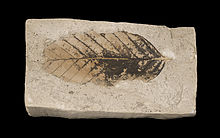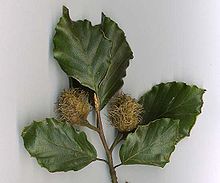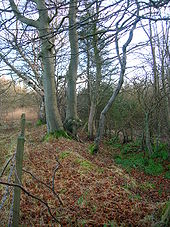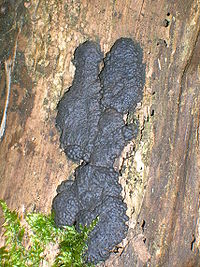- Fagus sylvatica
-
Fagus sylvatica
European Beech
European Beech foliage Scientific classification Kingdom: Plantae (unranked): Angiosperms (unranked): Eudicots (unranked): Rosids Order: Fagales Family: Fagaceae Genus: Fagus Species: F. sylvatica Binomial name Fagus sylvatica
L.Fagus sylvatica, the European Beech or Common Beech, is a deciduous tree belonging to the beech family Fagaceae.
Contents
Natural range
 Fagus sylvatica pliocenica – Museum of Toulouse
Fagus sylvatica pliocenica – Museum of Toulouse
The natural range extends from southern Sweden (with some isolated locations in southern Norway) to central Italy, west to France, southern England, northern Portugal, and central Spain, and east to northwest Turkey, where it intergrades with the Oriental Beech (F. orientalis), which replaces it further east. In the Balkans, it shows some hybridisation with Oriental Beech; these hybrid trees are named Fagus x taurica. In the southern part of its range around the Mediterranean, it grows only in mountain forests, at 600-1,800 m altitude. Although often regarded as native in southern England, recent evidence suggests that it did not arrive in England until about 4000 BC, or 2,000 years after the English Channel formed after the ice ages; it could have been an early introduction by Stone age man, who used the nuts for food.[1] The beech is classified as a native in the south of England and as a non-native in the north where it is often removed from 'native' woods.[2] Localised pollen records have been recorded in the North of England from the Iron Age by Sir Harry Godwin. Changing climatic conditions may put beech populations in southern England under increased stress and while it may not be possible to maintain the current levels of beech in some sites it is thought that conditions for beech in north-west England will remain favourable or even improve. It is often planted in Britain.
Description
It is a large tree, capable of reaching heights of up to 49 m (160 ft) tall[3] and 3 m (10 ft) trunk diameter, though more typically 25–35 m (80–115 ft) tall and up to 1.5 m (5 ft) trunk diameter. A 10-year-old sapling will stand about 4 m (13 ft) tall. It has a typical lifespan of 150 to 200 years, though sometimes up to 300 years. The appearance varies according to its habitat; in forest conditions, it tends to have a long, slender light-gray trunk with a narrow crown and erect branches, in isolation with good side light the trunk is short with a large and widely spreading crown with very long branches.
The leaves are alternate, simple, and entire or with a slightly crenate margin, 5–10 cm long and 3–7 cm broad, with 6-7 veins on each side of the leaf (7-10 veins in Fagus orientalis). When crenate, there is one point at each vein tip, never any points between the veins. The buds are long and slender, 15–30 mm long and 2–3 mm thick, but thicker (to 4–5 mm) where the buds include flower buds.
The leaves of beech are often not abscissed in the autumn and instead remain on the tree until the spring. This process is called marcescence. This particularly occurs when trees are saplings or when plants are clipped as a hedge (making beech hedges attractive screens, even in winter), but it also often continues to occur on the lower branches when the tree is mature.
The European Beech starts to flower when it is between 30–80 years old. The flowers are small catkins which appear shortly after the leaves in spring. The seeds, called beechnuts, are small triangular nuts 15–20 mm long and 7–10 mm wide at the base; there are two nuts in each cupule, maturing in the autumn 5–6 months after pollination. Flower and seed production is particularly abundant in years following a hot, sunny and dry summer, though rarely for two years in a row. The nuts are an important food for birds, rodents and in the past also humans. Slightly toxic to humans if eaten in large quantities due to the tannins they contain, the nuts were nonetheless pressed to obtain an oil in 19th century England that was used for cooking and in lamps. They were also ground to make flour, which could be eaten after the tannins were leached out by soaking.
Habitat
Climate and temperatures vary, though humidity needs to be constant. Little is required of the soil so long as it is well drained. Though not demanding of its soil type, the European Beech has several significant requirements: a humid atmosphere (precipitation well distributed throughout the year and frequent fogs) and well drained soil (it can not handle excessive stagnant water). It prefers moderately fertile ground, calcified or lightly acidic, therefore it is found more often on the side of a hill than at the bottom of a clayey basin. It tolerates rigorous winter cold, but is sensitive to spring frost. In Norway's oceanic climate planted trees grow well as far north as in Trondheim.
 Even, dense and old stand of beech trees prepared to be regenerated (watch the young trees underneath the old ones) in the Brussels part of the Sonian Forest
Even, dense and old stand of beech trees prepared to be regenerated (watch the young trees underneath the old ones) in the Brussels part of the Sonian Forest
A beech forest is very dark and few species of plant are able to survive there, where the sun barely reaches the ground. Young beeches prefer some shade and may grow poorly in full sunlight. In a clear-cut forest a European Beech will germinate and then die of excessive dryness. Under oaks with sparse leaf cover it will quickly surpass them in height and, due to the beech's dense foliage, the oaks will die from lack of sunlight. Foresters may assure the oaks' survival by cutting young beeches with a billhook 10 cm off the ground, which can produce magnificent bonsai.
The root system is shallow, even superficial, with large roots spreading out in all directions. European Beech forms ectomycorrhizas with a range of fungi including members of the genera Amanita, Boletus, Cantharellus, Hebeloma and Lactarius; these fungi are important in enhancing uptake of water and nutrients from the soil.
In the woodlands of southern Britain, beech is dominant over oak and elm south of a line from about north Suffolk across to Cardigan. Oak are the dominant forest trees north of this line. One of the most beautiful European Beech forests called Sonian Forest (Forêt de Soignes/Zoniënwoud) is found in the southeast of Brussels, Belgium. Beech is a dominant tree species in France and constitutes about 10% of French forests.
Phenology
Spring leaf budding by the European Beech is triggered by a combination of day length and temperature. Bud break each year is from the middle of April to the beginning of May, often with remarkable precision (within a few days). It is more precise in the north of its range than the south, and at 600 m than at sea level.
The European Beech invests significantly in summer and autumn for the following spring. Conditions in summer, particularly good rainfall, determine the number of leaves included in the buds. In autumn, the tree builds the reserves that will sustain it into spring. Given good conditions, a bud can produce a shoot with up to ten or more leaves. The terminal bud emits a hormonal substance in the spring that halts the development of additional buds. This tendency, though very strong at the beginning of their existence, becomes weaker in older trees.
It is only after the budding that root growth of the year begins. The first roots to appear are very thin (with a diameter of less than 0.5 mm). Later, after a wave of above ground growth, thicker roots grow in a steady fashion.
Uses
European Beech is a very popular ornamental tree in parks and large gardens, not only in Europe, but also in North America and New Zealand. It is frequently kept clipped to make attractive hedges. Since the early nineteenth century there have been a large number of ornamental cultivars of European Beech made by horticultural selection, often repeatedly; they include:
- Copper Beech or Purple Beech (Fagus sylvatica Purpurea Group) - leaves purple, in many selections turning deep spinach green by mid-summer. In the United States Charles Sprague Sargent noted the earliest appearance in a nurseryman's catalogue in 1820, but in 1859 "the finest Copper Beech in America... more than fifty feet high" was noted in the grounds of Thomas Ash, Esq., Throgs Neck, New York;[4] it must have been more than forty years old at the time.
- Fern-leaf Beech (Fagus sylvatica Heterophylla Group) - leaves deeply serrated to thread-like
- Dwarf Beech (Fagus sylvatica Tortuosa Group) - distinctive twisted trunk and branches
- Weeping Beech (Fagus sylvatica Pendula Group) - branches pendulous
- Dawyck Beech (Fagus sylvatica 'Dawyck') - fastigiate growth
- Golden Beech (Fagus sylvatica 'Zlatia') - leaves golden in spring
The wood of the European Beech is used in the manufacture of numerous objects and implements. Its fine and short grain makes it an easy wood to work with, easy to soak, dye (except its heartwood), varnish and glue. Steaming makes the wood even easier to machine. It has an excellent finish and is resistant to compression and splitting. Milling is sometimes difficult due to cracking and it is stiff when flexed. The density of the wood is 720 kg per cubic meter.[5] It is particularly well suited for minor carpentry, particularly furniture. From chairs to parquetry (flooring) and staircases, the European Beech can do almost anything other than heavy structural support, so long as it is not left outdoors. Its hardness make it ideal for making wooden mallets and workbench tops. The wood of the European Beech rots easily if it is not protected by a tar based on a distillate of its own bark (as used in railway sleepers). It is better for paper pulp than many other broadleaved trees though is only sometimes used for this. The code for its use in Europe is FASY (like FAgus SYlvatica). Common beech is also considered one of the best fire woods for fireplaces.[6][7]
Primary Product AM 01, a smoke flavouring, is produced from Fagus sylvatica L.[8]
The fruit of beeches are edible and have a nutty flavour. However it is not recommended to eat too many because they contain low concentrations of Trimethylamine, which is slightly toxic. Roasting both improves flavour and reduces the amount of Trimethylamine.
Pathogens
Detail of the tarcrust's structure.
Biscogniauxia nummularia is an Ascomycete primary pathogen of beech trees, causing strip-canker and wood rot. It can be found at all times of year and is not edible.
See also
Notes
- ^ Harris, E. (2002). Goodbye to Beech? Farewell to Fagus? Quarterly Journal of Forestry 96 (2): 97.
- ^ http://www.forestry.gov.uk/newsrele.nsf/WebPressReleases/1A301105A92950FE80257012002508A0 forestry.gov.uk
- ^ "Tall Trees". http://bomeninfo.nl/tall%20trees.htm.
- ^ Andrew Jackson Downing and Henry Winthrop Sargent, A Treatise on the Theory and Practice of Landscape Gardening, Adapted to North America 1859:150.
- ^ Steamed Beech. Niche Timbers. Accessed 20-08-2009.
- ^ http://www.jotuluk.com/Content/StandardPage____3178.aspx Nov 2, 2007
- ^ http://www.scoutbase.org.uk/library/hqdocs/facts/pdfs/fs315001.pdf
- ^ European Food Safety Authority (EFSA) Scientific Opinion on Safety of smoke flavour - Primary Product – AM 01 8 January 2010
External links
- Beech Tree Collection - Photographs By Louis K. Meisel, NY
- Images, location details, and measurements of remarkable beeches
Categories:- Fagus
- Trees of Europe
- Flora of the Mediterranean
- Flora of Great Britain
- Flora of Belgium
- Flora of France
- Flora of Germany
- Flora of Italy
- Flora of Portugal
- Flora of Sweden
- Flora of Spain
- Flora of Turkey
- Flora of Europe
- Trees of humid continental climate
- Trees of mild maritime climate
- Garden plants of Europe
- Ornamental trees
Wikimedia Foundation. 2010.



